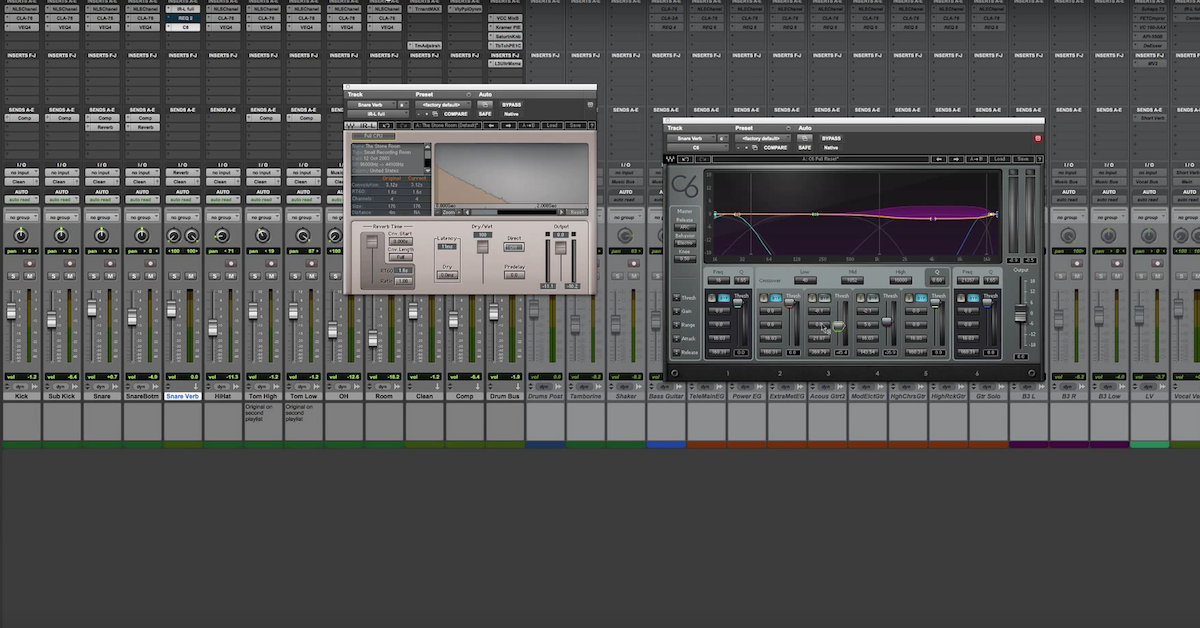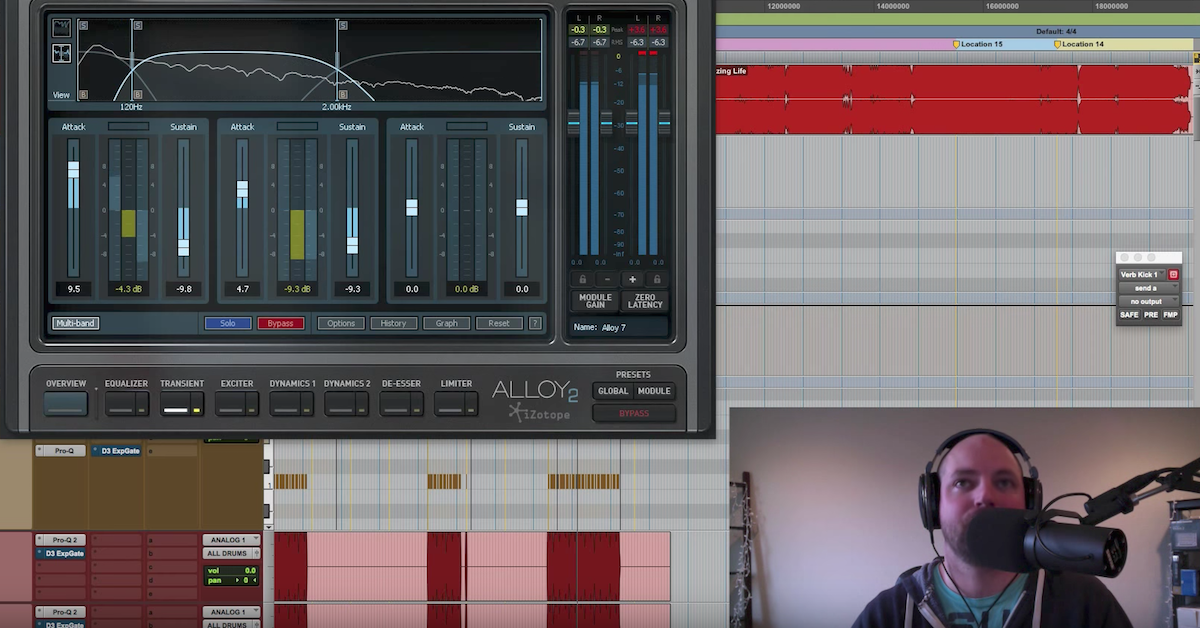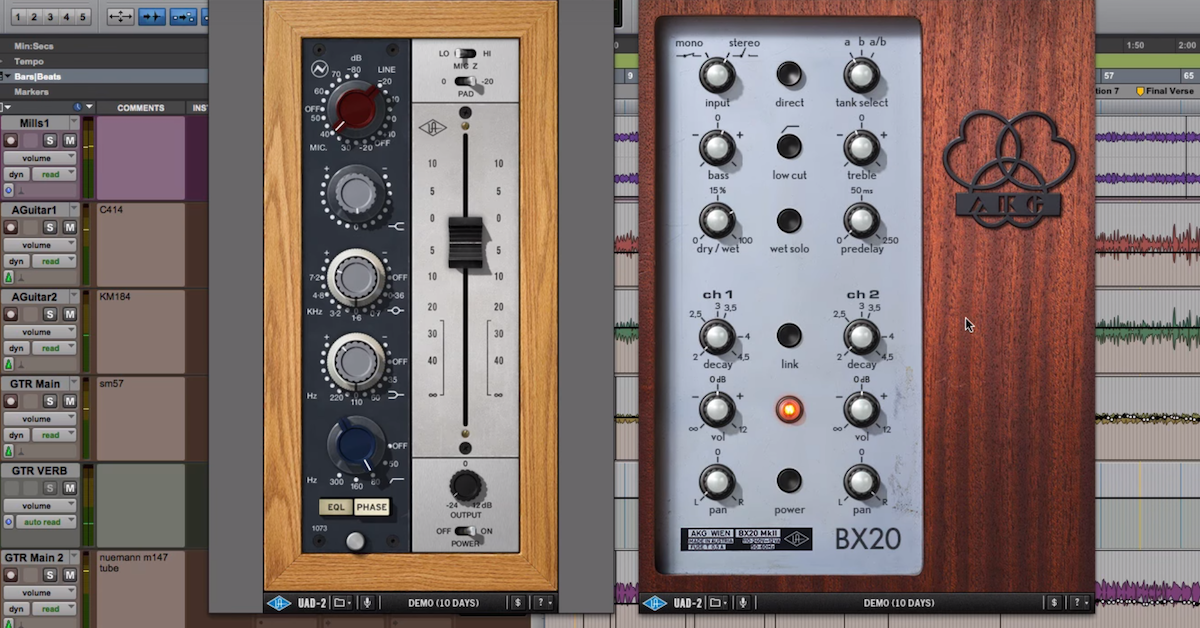Tips for Tightening Up Low End by Processing Reverb
Here’s a track that I’m working on.
[mix]
This is a song called “I Want Your Lovin’,” by the Nashville based band, Trapped on Earth. Definitely a group worth checking out. This song has got a good arrangement from the drums, with the bass, electric keys, electric guitar, horns and vocals. There’s a lot to fit together, and for this style of music, kind of jazzy pop funk, the bottom end plays such an important role in having a great mix.
I don’t know about you, but personally, when I’m working on a song, I want the bottom end to sound punchy, fat, tight, full, whatever you want to call it. When a song has it, it’s awesome, and when it doesn’t, it sucks. So I’ve tried lots of different techniques over the years to try and get this.
From putting high pass filters, and trying to mid/side processing on the mix buss, and also multi-band compression on the kick and the bass, and all of this kind of different techniques to do this, and those are all great, but what donned on me recently, and it was almost like an epiphany moment, where it was like, “How come I’m not paying attention to what’s going on on my reverb? I’m spending all my effort looking at the original recorded signals and trying to process those.”
What I was doing a lot of times was I was kind of rolling off too much of the low end on the dry tracks, because I didn’t want them to kind of wash out the bottom of my mix, but I noticed, “Hey, maybe the issue is more what’s going on on my reverb.” Reverb is great for the high frequencies, the mid-range frequencies, to kind of take something that sounds too dry, and give it a little bit of spaciousness. But the low end, you don’t want a lot of spaciousness. That’s going to make your low end sound kind of washy, and so what I started doing is looking at processing the reverb separate from the dry tracks, and I noticed, “Oh, this is making so much more sense now to do it this way where I can make sure the dry tracks have a bunch of — plenty of low end energy in them, but they’re not washing out my reverb.”
So let’s look at how I’m doing it in this track. We’ve got reverb in a couple of different locations on lead vocals over here. I’ve bussed them over to an auxiliary track, and I’ve got the Waves Abbey Road Plate. Great reverb for adding on vocals. Then over here on my instruments, the electric guitar, keys, and that kind of stuff, I’ve got the True Stereo Reverb from SofTube.
What you’ll notice a lot of times on reverb plugins is you have the ability to roll off some of the high frequencies. That’s great so it doesn’t sound too harsh or bright or brittle, and so I do that a lot, but you don’t always have control on the bottom end. Then also, over here on my drums, I have the room mics. So actually recorded reverb of the drum performance, rather than having to buss it out and use a plugin.
So let me show you what some of these sound like already in isolation. Here’s the drum room.
[drum room]
Here’s the electric guitar and keys going through their reverb.
[guitar and keys with reverb]
And the vocals.
[vocals with reverb]
So what I’m going to try and do now is go back through and remove some of the low frequencies. It’s not a complicated thing at all, it’s just a matter of finding the right balance.
So over here on my drums, I know on my room mics, right here, I want to have some spaciousness, but not wash out and have the kick drum sound too boomy on the low end. I suggest adding a simple high pass filter. It’s really going to clean up that bottom end.
[drum reverb, with high pass filter]
And don’t hesitate to be, you know, pretty extreme in terms of the processing. I’ve got a high pass filter up at like, 800Hz. Now, I’ve got the Q and the slope at 6 dB so it’s pretty gradual on the low frequencies. It doesn’t sound too abrupt, but you don’t have to worry about in the case of the room and the reverb sound, don’t just roll things off at 200-300Hz. Go all the way up into the mid-range and start cutting stuff, because that’s going to ensure that your reverb doesn’t wash things out in the 200, 300, 400Hz, important range for getting that tight low end sound.
You’ve got the direct mics, the kick, snare, all of those things. Those are going to be where your punch and your thickness come from. Same thing on the instruments. Over here, you know, I want my electric guitar to sound thick and full. I just put this high pass filter on the dry track. A lot of the times, what I ended up doing is getting rid of some important frequencies, where I might say, “Okay, I need to roll my electric guitars off at 150Hz.”
Well, that kind of made my electric guitars sound too thin, but then if I backed it off, maybe down — might push it to 100Hz, 90Hz, and bussed that over to my reverb, well, I need to process the reverb so the electric guitars don’t sound too washed out in the low frequencies. So here I’ve got another high pass filter. 460Hz in this case, and it’s really going to help make sure that bottom, you know, lower mid-range doesn’t sound too muddy. So here’s an example of that.
[guitars and keys]
So it’s a great way to get some clarity and balance out of the different tracks, but make sure they still have a sound that they’re existing in some real acoustic space.
Over here on the vocals, even though this is a female vocal track, you know, there’s not too much going on already, I’ve already rolled off stuff below 200Hz on the vocals, because that’s not — for the female, not that important of a range, but listen to what happens when I — up here at 750Hz, roll that off on the reverb.
All of a sudden, you make sure that the vocals aren’t muddying up that bottom end.
[vocals with high pass filter on reverb]
So it’s a really simple approach. Not complicated processing at all, and every little bit is going to help. Certainly, addressing things and making sure that they sound pretty good on the dry tracks by themselves, that’s going to be an important part of getting your tight, focused low end, but then, additionally, processing your reverb just takes it to that extra step, and you know, those are the differences between having a good mix and having a great mix.
So I’ll try to over exaggerate the reverb here in the track, and then I’ll bypass it, A/B back and forth, and you can hear, just removing those frequencies from the reverb does help on the track, tighten up that low end.
[exaggerated reverb, turning on and off high pass filters]
So there you go, guys. I’ll catch you next time. Take care!





